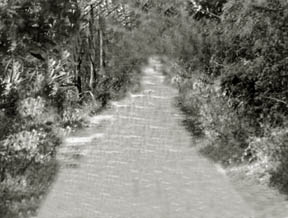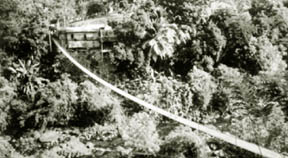|
observer |
|
|
|
|
|
OTHER LINKS |

|

|

|
Trekking
The air-conditioned confines of a car or coach allow you to only see for a brief moment what's outside, before you blast through on your way to your destination. Walking, on the other hand, is probably one of the better ways to see the island as it lets you get a feel of where you are, meet the people that live there and really experience all that is on offer. Trekking in Sri Lanka can be anything from a simple walk around a dry zone tank or an arduous assault on one of the many peaks or forests in our highlands. Some preparation, though, should be put in to your trek - to begin with, when and where you plan on going. The island is divided by a central mountain massif, which blocks out at any given time one of the two monsoons that are effective in either half of the country. It is generally the norm that the south west monsoon hits the wet zone during July to about September, and the north west monsoon the dry zone from November to around January the next year. Keeping this in mind should keep you high and dry! Setting off early will also let you make the most of your day before it becomes unbearably hot. Even in the hills with more than 5,000 feet between you and sea level, the sun can and does become quite strong. the rainy season brings with it muddy trails, water crossings and leeches, but it does offer a respite from the blistering heat.
The dry zone is dominated by temples. tanks and paddy fields, interspersed with forest and seeped in ancient history, ruins and artefacts. The early capitals of Anuradhapura and Polonnaruwa offer the present day traveller many opportunities to explore the area and its immense archaeological wealth on foot. In Anuradhapura, the Abhayagiri complex north of the ancient citadel offers awe-inspiring walks among the vestiges of the past and away from the throngs that frequent the more popular sites of the city. At Polonnaruwa, most of the ruins are centred within the brick walks of the 12th century capital and make a pleasant afternoon's walk. For something more interesting, walk past the rest-house and on to the northern bund (embankment) of the Parakrama Samudra tank. After encountering King Nissanka Malla's royal court, continue along the path over the bund and through patches of forest, to his predecessor King Parakramabahu's ruined waterfront summer palace. Apart from ruins the dry zone also has something to offer birdwatchers and wildlife enthusiasts. Treks along the coast, through salt flats and mangroves are, however, the best if you want to combine your hike with birdwatching. Hambantota in the south and Kalpitiya in the north west are two areas which are particularly good for coastal trekking. Turn off to your left at the last junction before reaching Kalpitiya town and this road takes you to the sand dunes and beyond to Dutch Bay. A walk on the sand bar in the evening is highly recommended, especially in April and May when the water is very calm. On your left will be the blue mirror of the ocean and to your right the green of the lagoon with the palm trees of the mainland in the background. Walking about a kilometre north takes you near a mosque, from where you can catch a ferry for the mainland. Another interesting coastal walk is from Kirinda to Palatupana at the eastern end of Ruhuna National Park. The crashing waves will be your companion here, offset by the scrub jungle and the dunes. It is best done at the crack of dawn. Take care not to walk too far, though, as you may find yourself within the National Park. Trekking in the highlands offers a totally different and yet very rewarding experience. The higher elevation means a cooler climate, crisp fresh air, and breathtaking scenery. The Horton Plains National Park is a natural choice for most trekkers and has well-marked trails that make it nearly impossible to get lost. Try some of the more uncommon approaches and trails, as you will be away from the hordes that descend on the plains during weekends. One way to get up to the plains is by walking on the jeep track above Diyagama East Estate (near Agrapatana). This takes you through a good selection of upper montane cloud forest and arrives on the plains about 500 yards off Farr Inn. A trail behind Farr Inn takes you to Kirigalpotta, Sri Lanka's second highest mountain. This is quite a long trail but the return journey can be completed in a day. You will get a totally different perspective of the plains looking at it from above - whenever there is a break in the clouds. It is possible to reach the plains from Belihul Oya, which lies to the south and below the rocky escarpment of World's End. The trail starts from the Belihul Oya rest house and follows what was once a bridle path to Horton Plains. Since this trek involves a massive ascent of nearly 1,500 meters it is partially a cross section of highland topography, geography and even society as Sinhalese villages give way to upcountry Tamil settlements. You pass Nagrak Estate and end up at World's End. There are also paths to get on to the plains from Loinorn Estate in Bogowantalawa and from Ohiya and Pattipola. For rainforest trekking, try Sinharaja and the larger yet less popular Kanneliya Forest Reserve. Both have survived logging programmes and are all that's left of the tropical rainforests that once dominated the entire south western quarter of the island. The sheer diversity of life here will leave you astounded. Sri Lanka has the highest biodiversity of amphibians and reptiles for its size anywhere in the world, so keep your eyes peeled for some examples. And if you are to enjoy your walk, carry a strong solution of salt water to deal with the leaches. There are many more places to go trekking. All it requires is a bit of investigation and preparation. Carry your own water and, even if you aren't planning on a picnic meal, it does make sense to carry some snacks with you. Nuts and raisins do wonders to keep your metabolism ticking over. They are also lightweight and easy to carry. Don't forget to take along a small bag for garbage, and, whenever possible, try and pick up what others have left behind. A clean trail is always a better trail. For Trekking Related info contact: Adventure Sports Lanka (Pvt) Ltd. E-mail: [email protected], web: www.actionlanka.com |
 Trekking in Sri Lanka is nothing new, although of course in former
times it was not a recreational activity. For instance, in 1679 Robert
Knox escaped the Kandyan Kingdom by walking to Arippu on the north west
coast, while in 1783 Jacob Haafner walked from Jaffna to Colombo and
back to accompany a cooper looking for work. Knox's and Haafner's
accounts of these adventurous treks make for fascinating reading, as
does the modern Trekker's Guide to Sri Lanka (1994).
Trekking in Sri Lanka is nothing new, although of course in former
times it was not a recreational activity. For instance, in 1679 Robert
Knox escaped the Kandyan Kingdom by walking to Arippu on the north west
coast, while in 1783 Jacob Haafner walked from Jaffna to Colombo and
back to accompany a cooper looking for work. Knox's and Haafner's
accounts of these adventurous treks make for fascinating reading, as
does the modern Trekker's Guide to Sri Lanka (1994).  And though it may sound masochistic, there is no better way to
experience a rainforest than the wet season. Since most treks are part
of a holiday or trip you can plan in advance and find out if there are
any interesting areas to explore on foot. Trekking can be done just
about anywhere in Sri Lanka. While it is not within the scope of this
article to describe each trail in detail, a few suggestions with
locations might be helpful.
And though it may sound masochistic, there is no better way to
experience a rainforest than the wet season. Since most treks are part
of a holiday or trip you can plan in advance and find out if there are
any interesting areas to explore on foot. Trekking can be done just
about anywhere in Sri Lanka. While it is not within the scope of this
article to describe each trail in detail, a few suggestions with
locations might be helpful. 







